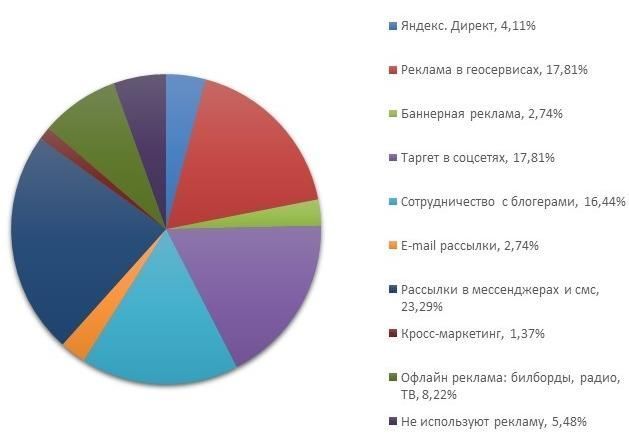
Omnichannel on the shelves. What is it, which companies are it suitable for and should they follow this trend?

The technologies we use in life and business are developing rapidly: in the last 10 years alone, many new sales channels and communication with audiences have appeared. This progress influences consumer behavior and cannot be stopped.
 Maria Gerasimenko -
Maria Gerasimenko - General Director of Fashion Advisers, business coach, expert in the field of management and development of fashion business. Main areas of activity: building business processes in the fashion industry, assortment matrix management, visual merchandising, sales and service management, development and implementation of loyalty programs.
Website: fashion-advisers.ru
Online school: school.fashion-advisers.ru
Telegram: @fashionadvisers
Today, being a customer-oriented company means being present in communication and sales channels that are convenient for the target audience, quickly responding to requests, and also striving to make the purchasing experience comfortable at all points of contact with the brand.
Customer journey map (CJM)
It is impossible to imagine the shopping experience as a funnel of stages through which the buyer predictably moves. Not only does the number of communication channels suitable for each stage of the funnel increase every year, but buyers also began to chaotically move from one stage to another: sometimes getting stuck at one of the stages, sometimes temporarily leaving for competitors, sometimes returning to the very beginning of the journey .
The term “buying journey” refers to all the touchpoints a customer has with a brand and the experiences a customer experiences during their “journey.” This path begins long before the actual sale and continues after it.
The beginning of the buyer's journey
This term usually refers to the stage when the buyer has the first signs of interest in purchasing the assortment that your brand works with. At this stage, the client may not yet be familiar with your company, but the idea of purchasing is already in the air.
I will give three examples:
Example # 1. Anastasia was interested in targeted advertising for a shoe store on the social network VK. She went to the brand's account to see other posts. The content was interesting and resonated with her values. She became a subscriber. She also subscribed to Instagram* (banned in the Russian Federation, as it belongs to Meta, a recognized extremist organization in the Russian Federation) and YouTube, since the content there turned out to be slightly different, but no less interesting. For about six months, she periodically looked through stories and read posts in the feed, getting inspired and strengthening her interest. During this time, she saw advertising for the brand from bloggers, publications in the media, and banner advertising. And as soon as the purchase trigger arose, she found the nearest brand store in her navigator, arrived and made a purchase.
Example #2. Sometimes the beginning of the buyer's journey begins right in the shopping center. Ivan walked past a store whose brand he had never encountered before. I saw a beautifully decorated display window, out of curiosity I went into the store and so began my shopping journey. The store is interestingly decorated, beautifully lit, pleasant music plays, and the current assortment is presented on the counters. Caring salespeople select suitable shoes for him, issue a loyalty card, tell him that the brand also has an online store and recommend subscribing to the brand’s account on social networks so as not to miss interesting information and keep up to date with brand news. So Ivan gradually becomes a loyal customer of the brand.
Example #3. Daria subscribes to a stylist’s blog, who periodically posts selections of items and puts together ready-made looks from them. She liked the boots from brand A. A couple of days later she sees these boots on a billboard, and the thought arises that she needs to find them on her usual marketplace and learn more about them. Then she goes to the marketplace and starts looking for a model of this brand, comparing it with others that are similar in quality, characteristics and price. In the recommendations she sees a similar model from brand B. And chooses to buy it. This is because the price of boots from brand A and brand B was almost the same, but the material was different. She opted for naturalness.
Channels of communication with the audience
I recently conducted a survey in our telegram channel “SECRETS OF FASHION BUSINESS” on the topic of what promotion channels are involved in the business of subscribers. And I received the following results: in first place - mailings in instant messengers and SMS (they are used by more than 23% of respondents), second place was shared by advertising in geoservices and targeting in social networks (17,81% each), in third place - cooperation with bloggers (16,44 .XNUMX%). Next come (in descending order): offline advertising, Yandex. Direct, banner advertising, email newsletters, cross-marketing.
As can be seen from the infographics, the majority of our subscribers use communication channels such as SMS and messenger messaging, targeted advertising on social networks, cooperation with bloggers and advertising in geoservices. At the same time, few people see the potential in contextual advertising, banners, and cross-marketing in these advertising channels. And 5,5% do not consider it necessary to use advertising at all.
At the same time, the more effective communication channels you cover, the more potential points of first contact you have with your target audience. By refusing to promote, you only leave yourself with the traffic passing by your store and lose out to your competitors.
Targeted advertising on social networks
Advertisements that are seen by social network users. Allows you to increase brand influence, reach your target audience, collect user data and increase their interest in your page.
Pros:
- large, growing audience;
- accurately reaching the target audience, thanks to the wide functionality of the advertising account;
- the ability to promote a brand only through a page on social networks, without a website or online store.
- high competition, and with increasing competition, the cost of advertising also increases;
- advertising creatives are often rejected at the moderation stage for unfounded reasons;
- Available only on the social networks VK and Odnoklassniki.
2.Collaboration with bloggers
Native advertising has the greatest potential for micro-influencer bloggers (bloggers from 1 to 100 thousand subscribers) who have established trusting contact with subscribers and a high rate of coverage and involvement.
Pros:
- a large selection of bloggers from different niches and regions;
- low cost;
- high audience involvement.
- relatively low coverage;
- In some cases, micro-influencers do not have advertising experience, which can affect the quality of publications.
3. Contextual advertising (Yandex.Direct)
Provides priority placement of your site in search results. One of the most effective ways to attract traffic to your website. Suitable for companies that have a website or online store.
Pros:
- shows high efficiency almost immediately after launch;
- convenient advertising account and measurable indicators;
- the opportunity to interest people who are looking not only for your brand, but also for your competitors’ brand;
- you only pay if someone clicks on your ad.
Cons:
- some users deliberately skip the first 3 lines in search results due to the “advertising” marking;
- the cost depends on the choice of keywords: the more popular the words, the higher the cost;
- the need to train in contextual advertising or attract competent specialists.
4. Banner advertising
Dynamic advertising banners and text and graphic blocks on websites. The main task of banner advertising is to attract an audience to the site. Just like contextual advertising, it is suitable for companies that have a website or online store.
Pros:
- shows results immediately, like contextual advertising;
- wide coverage;
- memorability, visual appeal;
- strengthens your brand image.
Cons:
- low click-through rate;
- user mistrust;
- the need to regularly update advertising creatives.
5.Advertising in geoservices
Your company card in Yandex and 2GIS navigators and maps. Allows you to find retail outlets both by name and category.
Pros:
- There are both paid and free formats for publishing cards;
- the card in the navigator contains basic information about the company: phone number, website, links to social networks, operating hours;
- rating and reviews about the company. When potential buyers see good reviews and high ratings, they initially have a higher level of trust;
- opportunity to get included in recommendations. A client can go to your company’s card, even if he was looking for a competitor. At the bottom of each card, Yandex publishes “Similar organizations.”
Cons:
- not suitable for online businesses that do not have a store, corner or pickup point.
6. E-mail mailings
Sending letters to clients' emails. An important nuance - we are talking only about mailings to the “warm” databases of your company, or the company of your partners. We strongly do not recommend sending mail to “cold” databases.
Pros:
- low advertising budget;
- the ability to create a mini-landing page with the required number of links in the html template;
- collecting statistics on opening letters and clicking on links.
Cons:
- low performance;
- In order for your audience to subscribe to your email newsletter and read these letters with pleasure, you have to carefully think through their content;
- active mailing and complaints from subscribers may cause blocking by mail services.
7 Newsletters via SMS and messengers
The newsletter comes directly to your clients’ phones: in messages or in messenger applications.
Pros:
- high conversion of opens;
- you can configure the robot and send messages automatically directly from the CRM system;
- People always have their phone at hand, so there is a high chance that your message will be read.
Cons:
- For mailing, you need to connect special third-party services or applications in CRM.
8 Cross marketing
In essence, cross-marketing is not a separate communication channel, but rather a joint advertising campaign with brands from related niches with a similar target audience. However, he also ended up on the list so that you don’t forget about him. The main goal of cross-marketing is the exchange between two or more companies with a target audience.
Cross-marketing can be carried out both with and without the use of an advertising budget: mutual publications, stories, mailings in messengers and e-mail, providing bonuses to partner clients, etc.
How to choose communication channels
1. Conduct an analysis of the target audience. You can do this using an online survey for your subscribers or focus groups with current customers. 2. Divide your target audience into segments. You should have at least 5-6 segments. 3. Determine the communication channels in which your target audience lives. 4. Start by introducing those channels through which you can reach priority segments of your target audience. 5. Analyze the result. If necessary, change the presentation of advertising, change communication channels.
To get the most out of your chosen communication channels, it is important to connect web analytics and UTM tags from the very beginning. They will allow you to analyze the effectiveness of each channel.
Also, in order to track customer requests, actual sales, exchanges and returns of goods, you will need a CRM - a program for automating and monitoring the company’s interaction with customers. Today there are many solutions for retail business. You can choose a finished product or modify it for your purposes.
Omnichannel provides that the company provides its customers with the opportunity to purchase goods in any convenient way: offline, online, or even study offers in the online space and come to buy in an offline store. There is even a separate term for the latter option - ROPO (research online purchase offline).
So, first things first. Let's look at the main retail sales channels, and also analyze their advantages and disadvantages.
1. Offline store
The most familiar format for most entrepreneurs. It can be located in a shopping center or be a free-standing retail outlet. Suitable for both large and small businesses.
Advantages:
- Personal communication increases the chances of a sale. If the buyer likes how the sellers communicate with him, then most likely he will be interested in the product itself;
- there is an opportunity to interact with the product: touch, try on;
- during a conversation, sellers have the opportunity to select the right words, intonation and use gestures;
- the seller has the opportunity to observe the client’s reaction and immediately adjust the offer.
Disadvantages:
- high rent;
- investments in the concept, design and renovation of the premises;
- costs of maintaining the atmosphere of the store: display windows, merchandising, lighting, music, aroma;
- the need for regular staff training.
2. Online store
A sales channel that is suitable for medium and large companies working with a unique product. It is a mandatory part of the omnichannel strategy.
Advantages:
- possibility of sales throughout the country and the world;
- collection of customer data: full name, contacts, date of birth, purchase history;
- the ability to analyze traffic sources, customer purchasing behavior (views by categories and selections of products, views of product cards, selection of sizes, adding to a wishlist, adding to cart, etc.);
- own marketing strategy.
Disadvantages:
- high cost of development and maintenance;
- a large advertising budget to attract targeted traffic to the site;
- you need your own logistics: warehouse, delivery, order processing, work with courier services
3. Marketplaces
Both small, medium and large businesses can sell on marketplaces. There are both companies that use the marketplace as their main sales channel, and brands that sell off the remnants of past collections there.
Advantages:
- easy start (relative to other sales channels);
- in your personal account you can track sales dynamics, maintain documentation, manage pricing and deliveries;
- a wide audience to whom you can sell throughout Russia and abroad;
- ready-made platform: website and mobile application;
- the marketplace completely undertakes the storage, packaging and delivery of the ordered goods to the client, the supplier only delivers the goods to the warehouse;
- a large network of pick-up points, the possibility of delivery to the client’s address.
Disadvantages:
- high competition in the clothing and footwear segment
- marketing activity is regulated by the marketplace, and not by the supplier of the goods, sometimes this can be at a loss to the supplier;
- Working on a marketplace, you cannot collect a customer base and work with loyalty;
-
It is difficult to maintain high ratings on marketplaces. First of all, they depend on reviews, while the supplier of the product does not have the opportunity to work with the negative before publishing the review;
- marketplaces often change the terms of the offer unilaterally, and there is a risk of receiving fines and penalties;
- The marketplace commission on orders averages from 5% to 25%, depending on the category of goods.
4.Social networks
According to statistics, if users are looking for a product on a social network, in 40% of cases it will be clothing or shoes. VK, Telegram and Instagram* (banned in the Russian Federation, as it belongs to Meta, a recognized extremist organization in the Russian Federation) are a mandatory combination for a shoe brand.
Insta has become a controversial sales and promotion channel for many. It has become more difficult to promote without targeting. And yet, work on this social network brings good results to many brands. Targeting has been replaced by advertising from micro-influencers. Also, do not forget about such a shareware way of exchanging audiences as mutual PR with partners from related niches.
Advantages:
- effectiveness in establishing contact between the target audience and your brand;
- potential for expanding the customer base;
- the opportunity not only to sell, but to convey brand values, strengthen loyalty, and manage the brand community;
- you can use such effective promotion tools as advertising with bloggers, targeted advertising and content marketing.
Disadvantages:
- the time required to create high-quality content, or outsource an SMM team;
- costs associated with advertising and the need for a targetologist;
- there is a risk of account blocking - this could be the machinations of competitors or a platform error. And given that not all social networks support service is prompt, you may lose access to it forever.
How to choose a sales channel
1. Analyze your competitors: in which channels is their brand represented, how do they present their product and interact with the audience, what results do they have? Notice their strengths and mistakes. 2. Select those channels where your target audience lives. 3. Calculate the economic model for the selected sales channels. In particular, take into account the costs of advertising, photo shoots, work of contractors, rental and renovation of retail space.
4. Link the selected channels into a single system using a CRM system. 5. Analyze the results for each sales channel on an ongoing basis.
The most important features
Omnichannel involves not only the use of several communication and sales channels, but also a seamless transition between them. In this matter, consistency is important: combining channels using CRM, a single tone of voice, a single corporate identity, friendly and trained employees who communicate with the client throughout the entire purchasing journey.
In conclusion, implementing an omnichannel strategy into a business is a great way to increase your reach to potential customers, make the purchasing process easier and faster, and also increase customer loyalty and increase profits.
Overall, an omnichannel strategy is necessary for every business that wants to remain competitive in today's footwear market.
Photo: GEOX SS'23
| Please rate the article |
Materials on the topic

Technology Selling Issues

Does an online store need omnichannel?

I doubt and object: how to find an approach to difficult clients?

How to create selling visual content for online based on the identified unique selling proposition?

How the buyer makes a purchase decision and psychological methods to influence it
Popular
 We are ready for active development in the Russian market
Friedrich Naumann, CEO of the Tamaris brand, told Shoes Report about the company’s ambitious plans, business development in Russia and expansion of the retail network, and also shared details about new collections and launches.
We are ready for active development in the Russian market
Friedrich Naumann, CEO of the Tamaris brand, told Shoes Report about the company’s ambitious plans, business development in Russia and expansion of the retail network, and also shared details about new collections and launches.
 Coach turned to Big Data analysis and won the interest of a young audience
American handbag brand Coach has planned the success of its Tabby model among a younger audience, Generation Z, by turning to big data analysis, abandoning traditional and analogue tools, such as human intuition or the ability of any executive to sense “which way the wind will blow,” writes B.O.F.
Coach turned to Big Data analysis and won the interest of a young audience
American handbag brand Coach has planned the success of its Tabby model among a younger audience, Generation Z, by turning to big data analysis, abandoning traditional and analogue tools, such as human intuition or the ability of any executive to sense “which way the wind will blow,” writes B.O.F.
 IDOL updates the concept
The IDOL brand, part of the Melon Fashion Group portfolio, opened the first flagship in an updated concept in the Aviapark shopping center in Moscow.
IDOL updates the concept
The IDOL brand, part of the Melon Fashion Group portfolio, opened the first flagship in an updated concept in the Aviapark shopping center in Moscow.
 Louis Vuitton opens a new factory in Italy
Louis Vuitton has opened its second shoe factory in Italy. After opening the first one in Fiesso d'Artico in Veneto, the LVMH flagship brand has just opened a new production site dedicated to this category of footwear in the industrial zone of Civitano in the Marche region. There is also another brand production facility in Tuscany, where bags and leather accessories are produced, writes fr.fashionnetwork.com.
Louis Vuitton opens a new factory in Italy
Louis Vuitton has opened its second shoe factory in Italy. After opening the first one in Fiesso d'Artico in Veneto, the LVMH flagship brand has just opened a new production site dedicated to this category of footwear in the industrial zone of Civitano in the Marche region. There is also another brand production facility in Tuscany, where bags and leather accessories are produced, writes fr.fashionnetwork.com.
 The Euro Shoes@CAF exhibition will be held in Almaty
From March 11 to 13, the Euro Shoes@CAF (Central Asia Fashion) exhibition will be held in Almaty at the Atakent exhibition complex. The exhibition, which is the largest international event in the fashion industry in Central Asia, will present collections of clothing, shoes and accessories.
The Euro Shoes@CAF exhibition will be held in Almaty
From March 11 to 13, the Euro Shoes@CAF (Central Asia Fashion) exhibition will be held in Almaty at the Atakent exhibition complex. The exhibition, which is the largest international event in the fashion industry in Central Asia, will present collections of clothing, shoes and accessories.
 VAGA SHOES is a new participant in the Euro Shoes premiere collection
The Russian women's shoe factory VAGA SHOES will take part for the first time in the international exhibition of footwear and accessories Euro Shoes premiere collection in Moscow.
VAGA SHOES is a new participant in the Euro Shoes premiere collection
The Russian women's shoe factory VAGA SHOES will take part for the first time in the international exhibition of footwear and accessories Euro Shoes premiere collection in Moscow.
 Euro Shoes will start operating on February 19 in Moscow!
The winter session of the international exhibition of footwear and accessories Euro Shoes premiere collection will be held in Moscow at the Expocenter from February 19 to 22. The organizers promise the presence of all the main participants at the exhibition, as well as new names from Europe, Asia and Russia.
Euro Shoes will start operating on February 19 in Moscow!
The winter session of the international exhibition of footwear and accessories Euro Shoes premiere collection will be held in Moscow at the Expocenter from February 19 to 22. The organizers promise the presence of all the main participants at the exhibition, as well as new names from Europe, Asia and Russia.
 American buyers couldn't buy Birkin bags and sued Hermès
French fashion house Hermès is facing a lawsuit in California from two customers who were unable to purchase exclusive Birkin bags. The fashion house is accused of unfair commercial practices.
American buyers couldn't buy Birkin bags and sued Hermès
French fashion house Hermès is facing a lawsuit in California from two customers who were unable to purchase exclusive Birkin bags. The fashion house is accused of unfair commercial practices.
 John Galliano and Christian Louboutin created the Tabi collection for Maison Margiela
Maison Margiela creative director John Galliano and French shoe designer Christian Louboutin released a shoe collaboration that was included in the Maison Margiela Artisanal spring 2024 couture collection. The design duo created six versions of the Tabi shoe. All shoe models in the collection have a split toe - a characteristic touch of the signature Tabi shoe model of the Maison Margiela brand. And Christian Louboutin gave the shoe its signature red sole.
John Galliano and Christian Louboutin created the Tabi collection for Maison Margiela
Maison Margiela creative director John Galliano and French shoe designer Christian Louboutin released a shoe collaboration that was included in the Maison Margiela Artisanal spring 2024 couture collection. The design duo created six versions of the Tabi shoe. All shoe models in the collection have a split toe - a characteristic touch of the signature Tabi shoe model of the Maison Margiela brand. And Christian Louboutin gave the shoe its signature red sole.
 Why Rendez-Vous and Yandex Lavka released a “bread bag”
Shoe retailer Rendez-Vous announced the launch of a spring collaboration with Yandex Lavka and released a roll that resembles the shape of a woman’s handbag. This “Bread Bag” is presented in the Yandex.Lavka application at a price of 249 rubles. On the product packaging there is a promotional code for 1000 rubles, which can be spent in the Rendez-Vous network.
Why Rendez-Vous and Yandex Lavka released a “bread bag”
Shoe retailer Rendez-Vous announced the launch of a spring collaboration with Yandex Lavka and released a roll that resembles the shape of a woman’s handbag. This “Bread Bag” is presented in the Yandex.Lavka application at a price of 249 rubles. On the product packaging there is a promotional code for 1000 rubles, which can be spent in the Rendez-Vous network.
 Camper has released innovative sneakers - designers
Spanish brand Camper's new Roku sneaker features six interchangeable components to create up to 64 different looks and color combinations. Roku means "six" in Japanese.
Camper has released innovative sneakers - designers
Spanish brand Camper's new Roku sneaker features six interchangeable components to create up to 64 different looks and color combinations. Roku means "six" in Japanese.
 Christian Louboutin presented a collection in a cowboy style
At the Loubi Show in Paris, the French luxury brand Christian Louboutin presented its fall 2024 collection, following the trend - in the style of the Wild West. It included cowboy boots and rhinestone loafers.
Christian Louboutin presented a collection in a cowboy style
At the Loubi Show in Paris, the French luxury brand Christian Louboutin presented its fall 2024 collection, following the trend - in the style of the Wild West. It included cowboy boots and rhinestone loafers.
 Fashion Week takes place in Moscow
Fashion Week takes place in the Russian capital. Events include fashion shows, markets where you can purchase clothes, bags and accessories, and a B2B Showroom for fashion industry professionals.
Fashion Week takes place in Moscow
Fashion Week takes place in the Russian capital. Events include fashion shows, markets where you can purchase clothes, bags and accessories, and a B2B Showroom for fashion industry professionals.
 Fashion trends Fall-Winter 2023/24 for commercial footwear purchases
Permanent contributor to Shoes Report. Elena Vinogradova, an expert in sales and purchases in the fashion business, prepared an overview of the trends for the autumn-winter 2023/24 season especially for us.
Fashion trends Fall-Winter 2023/24 for commercial footwear purchases
Permanent contributor to Shoes Report. Elena Vinogradova, an expert in sales and purchases in the fashion business, prepared an overview of the trends for the autumn-winter 2023/24 season especially for us.
 MSCHF and Crocs launch "Big Yellow Boots"
Creator of the Big Red Boots, Brooklyn brand MSCHF has teamed up with American plastic clog and sandal brand Crocs for another oversized shoe. The new Big Yellow Boots will go on sale on August 9th.
MSCHF and Crocs launch "Big Yellow Boots"
Creator of the Big Red Boots, Brooklyn brand MSCHF has teamed up with American plastic clog and sandal brand Crocs for another oversized shoe. The new Big Yellow Boots will go on sale on August 9th.
 Five rules of professional lighting for a shoe store - something that is relevant in any season
When developing a lighting concept for shoe retailers, it is important to take into account not only the history of the brand, the architectural content of the premises, the target audience of the stores, but also the seasonality of the goods. With the onset of the cold season, client preferences change: bright weightless shoes are replaced by more massive models in discreet dark colors. Despite significant differences in summer and winter collections, the overall philosophy of the brand, its recognition should remain unchanged at any time of the year. Tatyana Ryzhova, an SR lighting expert in fashion retail, has identified five basic rules for a competent lighting concept for a shoe store for readers of the magazine, which will help to present winter assortment to customers in a winning way.
Five rules of professional lighting for a shoe store - something that is relevant in any season
When developing a lighting concept for shoe retailers, it is important to take into account not only the history of the brand, the architectural content of the premises, the target audience of the stores, but also the seasonality of the goods. With the onset of the cold season, client preferences change: bright weightless shoes are replaced by more massive models in discreet dark colors. Despite significant differences in summer and winter collections, the overall philosophy of the brand, its recognition should remain unchanged at any time of the year. Tatyana Ryzhova, an SR lighting expert in fashion retail, has identified five basic rules for a competent lighting concept for a shoe store for readers of the magazine, which will help to present winter assortment to customers in a winning way.
 Bertsy: what to look for when choosing a model
Bertsy and tactical boots are becoming more and more relevant footwear, and not only because of the start of the hunting season. In Russia, there are several dozen enterprises producing this type of footwear. Oleg Tereshin, Deputy Chief Technologist of ZENDEN, told Shoes Report about the differences and features of ankle boots and what you should pay attention to when buying them in specialized retail and online.
Bertsy: what to look for when choosing a model
Bertsy and tactical boots are becoming more and more relevant footwear, and not only because of the start of the hunting season. In Russia, there are several dozen enterprises producing this type of footwear. Oleg Tereshin, Deputy Chief Technologist of ZENDEN, told Shoes Report about the differences and features of ankle boots and what you should pay attention to when buying them in specialized retail and online.
 I doubt and object: how to find an approach to difficult clients?
How good and serene would be the work of a salesperson if the customers were calm, cheerful, always knew exactly what they wanted, and bought, bought, bought! It is a pity that this is possible only in dreams. Therefore, we will not dream, but we will act. Together with Maria Gerasimenko, a permanent author of SR, we understand the doubts and objections of buyers and build a strategy for working with them. Our expert pays special attention to the two main objections of buyers, on which 82% of sales are lost.
I doubt and object: how to find an approach to difficult clients?
How good and serene would be the work of a salesperson if the customers were calm, cheerful, always knew exactly what they wanted, and bought, bought, bought! It is a pity that this is possible only in dreams. Therefore, we will not dream, but we will act. Together with Maria Gerasimenko, a permanent author of SR, we understand the doubts and objections of buyers and build a strategy for working with them. Our expert pays special attention to the two main objections of buyers, on which 82% of sales are lost.
 EURO SHOES presents an updated section of the GLOBAL SHOES exhibition with collections of shoe and bag brands from Asian countries
EURO SHOES premiere collection is expanding. Along with the traditional pool of leading European footwear brands from Germany, Spain, Italy and Turkey, several dozen footwear and bag brands from the Middle Kingdom will be presented in the GLOBAL SHOES section at the Moscow Expocentre from August 29 to September 1.
EURO SHOES presents an updated section of the GLOBAL SHOES exhibition with collections of shoe and bag brands from Asian countries
EURO SHOES premiere collection is expanding. Along with the traditional pool of leading European footwear brands from Germany, Spain, Italy and Turkey, several dozen footwear and bag brands from the Middle Kingdom will be presented in the GLOBAL SHOES section at the Moscow Expocentre from August 29 to September 1.
 Two prominent Russian fashion designers Vyacheslav Zaitsev and Valentin Yudashkin passed away
One after another, two days apart, Vyacheslav Zaitsev and Valentin Yudashkin, outstanding fashion designers, whose work for the whole world was a kind of hallmark of fashionable Russia, left this world.
Two prominent Russian fashion designers Vyacheslav Zaitsev and Valentin Yudashkin passed away
One after another, two days apart, Vyacheslav Zaitsev and Valentin Yudashkin, outstanding fashion designers, whose work for the whole world was a kind of hallmark of fashionable Russia, left this world.
 World Footwear Yearbook: Global footwear production reaches 23,9 billion pairs and is back to pre-pandemic levels
The Portuguese association of shoe manufacturers APICCAPS published the 13th edition of the international statistical bulletin World Footwear Yearbook for 2023, according to which in 2022 the production and export of shoes worldwide increased by 7,6% and 9%, respectively, and the world production of shoes reached 23,9 billion couples and returned to pre-pandemic levels.
World Footwear Yearbook: Global footwear production reaches 23,9 billion pairs and is back to pre-pandemic levels
The Portuguese association of shoe manufacturers APICCAPS published the 13th edition of the international statistical bulletin World Footwear Yearbook for 2023, according to which in 2022 the production and export of shoes worldwide increased by 7,6% and 9%, respectively, and the world production of shoes reached 23,9 billion couples and returned to pre-pandemic levels.
 Rostov footwear brand Novak presented a collection of sneakers and sneakers
In the spring-summer 2023 season, the Rostov-on-Don shoe brand Novak presented a cute collection of sneakers and sneakers for every day. The upper of the shoe is made of genuine leather, suede, nubuck, the sole is made of light EVA.
Rostov footwear brand Novak presented a collection of sneakers and sneakers
In the spring-summer 2023 season, the Rostov-on-Don shoe brand Novak presented a cute collection of sneakers and sneakers for every day. The upper of the shoe is made of genuine leather, suede, nubuck, the sole is made of light EVA.
 How to create selling visual content for online based on the identified unique selling proposition?
What is a USP (unique selling proposition) and what is it for? Why is the USP creation service in great demand among fashion retailers today? How to create a working USP? Answers questions and provides step-by-step guidance on how to define your unique selling proposition and work with it to increase online sales, Tatyana Vasilyeva, an SR expert in the promotion and development of fashion brands.
How to create selling visual content for online based on the identified unique selling proposition?
What is a USP (unique selling proposition) and what is it for? Why is the USP creation service in great demand among fashion retailers today? How to create a working USP? Answers questions and provides step-by-step guidance on how to define your unique selling proposition and work with it to increase online sales, Tatyana Vasilyeva, an SR expert in the promotion and development of fashion brands.
 Shoe educational program: what shoe soles are made of
“What is the difference between TEP and EVA? What does tunit promise me? Is PVC glue? What is the sole of these shoes made of? ”- the modern buyer wants to know everything. In order not to smash his face in front of him and be able to explain whether such a sole suits him in soles, carefully read this article. In it, process engineer Igor Okorokov tells what materials the soles of shoes are made of and what makes each of them so good.
Shoe educational program: what shoe soles are made of
“What is the difference between TEP and EVA? What does tunit promise me? Is PVC glue? What is the sole of these shoes made of? ”- the modern buyer wants to know everything. In order not to smash his face in front of him and be able to explain whether such a sole suits him in soles, carefully read this article. In it, process engineer Igor Okorokov tells what materials the soles of shoes are made of and what makes each of them so good.
 How to set prices that will earn
Some businessmen still confuse the concept of margin with the concept of trade margins and set prices for their goods, guided solely by the example of competitors. No wonder they go broke! Analyst at the Academy of Retail Technologies Maxim Gorshkov gives several tips and formulas with which you can set not only ruinous, but also profitable prices.
How to set prices that will earn
Some businessmen still confuse the concept of margin with the concept of trade margins and set prices for their goods, guided solely by the example of competitors. No wonder they go broke! Analyst at the Academy of Retail Technologies Maxim Gorshkov gives several tips and formulas with which you can set not only ruinous, but also profitable prices.
 Sales of shoes and accessories: effective techniques for business rhetoric
Which speech modules are effective in communicating with potential and current customers of shoe stores, and which are not, Anna Bocharova, a business consultant, knows.
Sales of shoes and accessories: effective techniques for business rhetoric
Which speech modules are effective in communicating with potential and current customers of shoe stores, and which are not, Anna Bocharova, a business consultant, knows.
 We form the salary of sellers: expert advice
“How do you charge your consultants for personal or general sales?” Is one of the most popular questions causing a lot of controversy and gossip on the online forums of retail business owners. Indeed, how to properly form the earnings of sellers? But what about bonuses, where to get a sales plan from, do employees allow them to buy goods at discounted stores? In search of truth, the Shoes Report turned to a dozen shoe retailers, but no company wanted to disclose its motivation system - the process of its development was too complicated and individual. Then we asked four business consultants, and finally became convinced that the topic of seller motivation is very complex, because even our experts could not come to a common opinion.
We form the salary of sellers: expert advice
“How do you charge your consultants for personal or general sales?” Is one of the most popular questions causing a lot of controversy and gossip on the online forums of retail business owners. Indeed, how to properly form the earnings of sellers? But what about bonuses, where to get a sales plan from, do employees allow them to buy goods at discounted stores? In search of truth, the Shoes Report turned to a dozen shoe retailers, but no company wanted to disclose its motivation system - the process of its development was too complicated and individual. Then we asked four business consultants, and finally became convinced that the topic of seller motivation is very complex, because even our experts could not come to a common opinion.
 The whole truth about Bayer. Who is he and how to become one?
Bayer is no longer a new, but still a popular and sought-after profession. It’s fashionable to be a buyer. Buyers are at the origins of the emergence and development of trends. If the designer offers his vision of fashion in the season, then the buyer selects the most interesting commercial ideas. It is on buyers that the policy of sales of stores and what, in the end, the buyer will wear depends on. This profession is surrounded by a magical fleur, often associated with a lack of understanding of what exactly is the work of a buyer.
The whole truth about Bayer. Who is he and how to become one?
Bayer is no longer a new, but still a popular and sought-after profession. It’s fashionable to be a buyer. Buyers are at the origins of the emergence and development of trends. If the designer offers his vision of fashion in the season, then the buyer selects the most interesting commercial ideas. It is on buyers that the policy of sales of stores and what, in the end, the buyer will wear depends on. This profession is surrounded by a magical fleur, often associated with a lack of understanding of what exactly is the work of a buyer.
 Technology Selling Issues
There is nothing worse than meeting the buyer with the words “Hello, can I help you with something?”, Because the seller works in the store just to help. Criticizing this well-established pattern of communication with the buyer, Andrei Chirkarev, business coach for effective sales and the founder of the New Economy project, shares the technology of truly selling issues with readers of Shoes Report.
Technology Selling Issues
There is nothing worse than meeting the buyer with the words “Hello, can I help you with something?”, Because the seller works in the store just to help. Criticizing this well-established pattern of communication with the buyer, Andrei Chirkarev, business coach for effective sales and the founder of the New Economy project, shares the technology of truly selling issues with readers of Shoes Report.
 Fur, and not only: types of lining
In the production of winter footwear, various materials are used that are designed to retain heat and meet the requirements of consumers: natural sheepleather, artificial fur, artificial fur from natural wool and others. All types of lining fur have their own advantages and disadvantages. Let's consider the properties of each of them.
Fur, and not only: types of lining
In the production of winter footwear, various materials are used that are designed to retain heat and meet the requirements of consumers: natural sheepleather, artificial fur, artificial fur from natural wool and others. All types of lining fur have their own advantages and disadvantages. Let's consider the properties of each of them.
 Retail Arithmetic
Before you begin to solve specific problems, you need to find out how accurately all the leaders of your company understand the basic terminology of retail.
Retail Arithmetic
Before you begin to solve specific problems, you need to find out how accurately all the leaders of your company understand the basic terminology of retail.
 How to fire a worker without tears, scandal and trial
Sooner or later, any manager is faced with the need to part with an employee. Properly and on time the dismissal procedure will save the company money, and the boss himself - nerves and time. But why sometimes, knowing that a break in relations is inevitable, we put off the decision for months?
How to fire a worker without tears, scandal and trial
Sooner or later, any manager is faced with the need to part with an employee. Properly and on time the dismissal procedure will save the company money, and the boss himself - nerves and time. But why sometimes, knowing that a break in relations is inevitable, we put off the decision for months?










